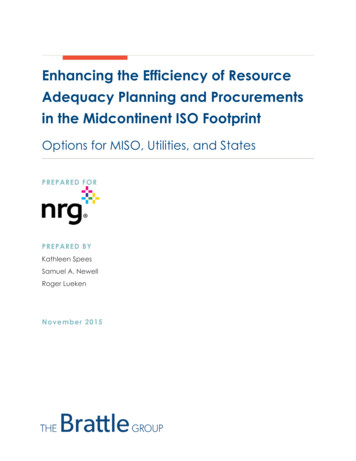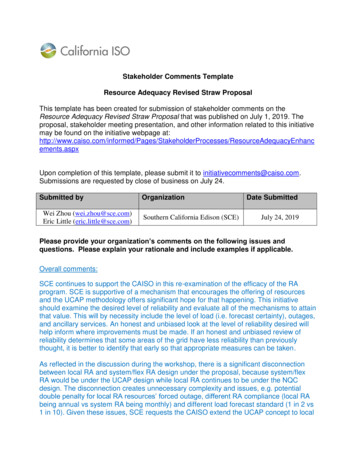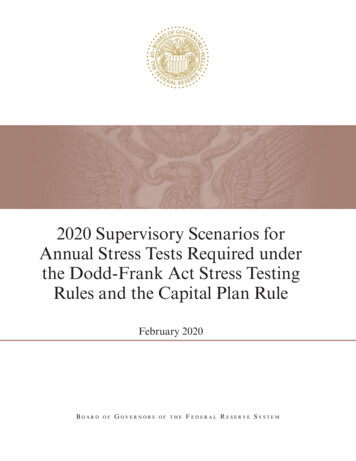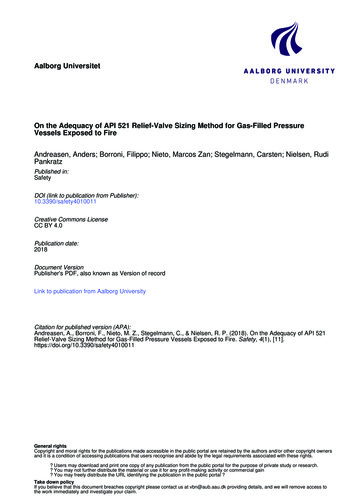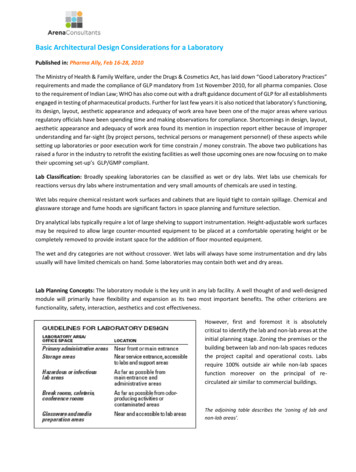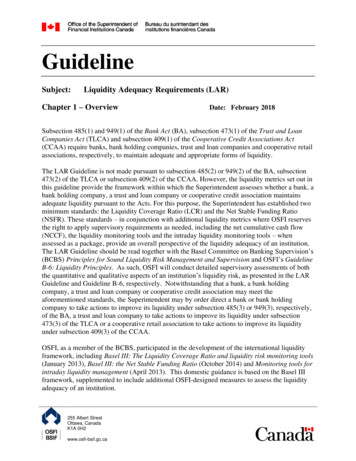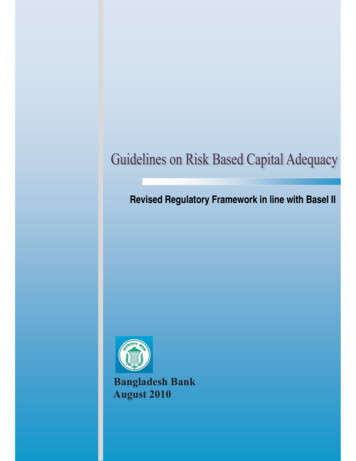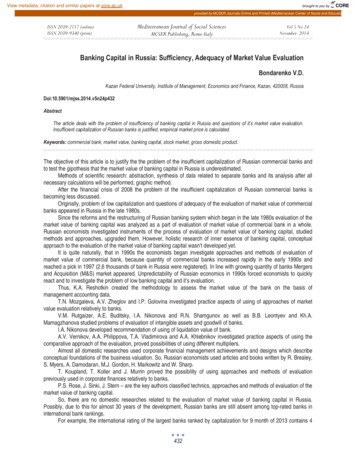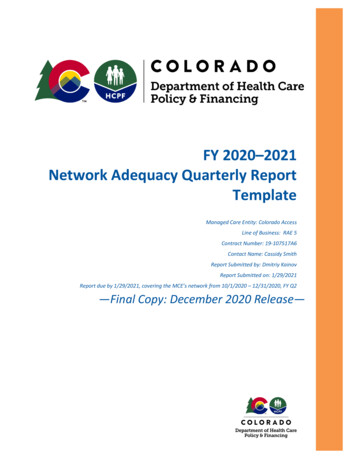
Transcription
FY 2020–2021Network Adequacy Quarterly ReportTemplateManaged Care Entity: Colorado AccessLine of Business: RAE 5Contract Number: 19-107517A6Contact Name: Cassidy SmithReport Submitted by: Dmitriy KainovReport Submitted on: 1/29/2021Report due by 1/29/2021, covering the MCE’s network from 10/1/2020 – 12/31/2020, FY Q2—Final Copy: December 2020 Release—
ContentsInstructions for Using the Network Adequacy Quarterly Report Template . 1-1Definitions . 1-1Report Instructions . 1-2Questions . 1-2Network Adequacy . 2-1Establishing and Maintaining the MCE Network . 2-1Network Changes and Deficiencies . 3-1Network Changes . 3-1Inadequate Network Policies . 3-2Appointment Timeliness Standards . 4-1Appointment Timeliness Standards. 4-1Time and Distance Standards. 5-1Health Care Network Time and Distance Standards . 5-1Appendix A. Single Case Agreements (SCAs) . A-1Appendix B. Optional MCE Content. B-1Instructions for Appendices. B-1Optional MCE Content . B-1Appendix C. Optional MCE Content . C-1FY 2020–2021 Network Adequacy ReportState of Colorado—Final Copy: June 2020 Release—Page iCO2020-21 Network Adequacy Quarterly Report F1 0620
Instructions for Using the Network Adequacy Quarterly Report TemplateThis document contains the June 2020 release of a standardized template for use by all ColoradoMedicaid or CHP Managed Care Entities (MCEs) for quarterly Network Adequacy (NA) reporting tothe Colorado Department of Health Care Policy and Financing (HCPF). Each MCE should generate onequarterly NA report for each applicable line of business (i.e., CHP MCO, Medicaid MCO, and RAE);the report shall contain template elements applicable to the line of business. Network categories requiredfor quarterly reporting are defined in the CO Network Adequacy Crosswalk Definitions (June 2020version).The practitioners, practice sites, and entities included in the quarterly NA report will include ordering,referring, and servicing contractors that provide care through a Colorado Medicaid or CHP MCE. Toensure consistent data collection across MCEs, each MCE must use this HCPF-approved report template(MS Word and MS Excel templates) to present the MCE’s quarterly NA report and data for thecorresponding practitioners, practice sites, and entities. Report due dates will align with those outlined inthe MCE’s contract, unless otherwise stated.Fiscal Year (FY) Quarter (Q) ReportedMonths Included in the ReportFY 2019-20 Q4April, May, JuneFY 2020-21 Q1July, August, SeptemberFY 2020-21 Q2October, November, DecemberFY 2020-21 Q3January, February, MarchDefinitions “MS Word template” refers to the CO2020-21 Network Adequacy Quarterly Report WordTemplate F1 0620 document.“MS Word MCE Data Requirements” refers to the CO2020-21 NetworkAdequacy MCE DataRequirements F1 0620 document that contains instructions for each MCE’squarterly submission of member and network data.“MS Excel Geoaccess Compliance template” refers to the CO2020-21 NetworkAdequacy Quarterly Report Excel Template MCE Type Geoaccess Compliance spreadsheet.– MCEs will use this file to supply county-level results from their geoaccess compliancecalculations, including practitioner to member ratios and time/distance calculations.Use the Colorado county designations from the Colorado Rural Health Center to define a county asurban, rural, or frontier; the most recent county-level map is available at the following website:– �� Note: Urban counties with rural areas (e.g., Larimer County) should be reported with the ruralcounties and use rural time/distance standards.FY 2020–2021 Network Adequacy ReportState of Colorado—Final Copy: June 2020 Release—Page 1-1CO2020-21 Network Adequacy Quarterly Report F1 0620
A “practice site” or “practice” refers to a physical healthcare facility at which the healthcare serviceis performed.A “practitioner” refers to an individual that personally performs the healthcare service, excludingsingle case agreement (SCA) practitioners.An “entity” refers to a facility-level healthcare service location (e.g., hospital, pharmacy, imagingservice facility, and/or laboratory).Report InstructionsEach MCE should use this template to generate one quarterly NA report for each applicable line ofbusiness (i.e., CHP MCO, Medicaid MCO, and RAE); the report shall contain template elementsapplicable to the line of business. The MCE should update the highlighted, italicized data fields on thecover page of this template to reflect their contact information, contract information, and report datesassociated with the current report submission.This report template contains a comprehensive list of NA requirements for the CHP MCO, MedicaidMCO, and RAE lines of business. Each table in this MS Word document contains a header row whichconfirms the applicable line(s) of business for each response. The table below shows expected networkcategories by MCE type. The accompanying MS Excel spreadsheets contain tabs in which network datacan be imported (e.g., member counts, ratio results, time/distance calculation results).Network CategoryCHP MCOMedicaid MCORAEFacilities (Entities)(Hospitals, Pharmacies, Imaging Services, Laboratories)XXPrenatal Care and Women’s Health ServicesXXXPrimary Care Providers (PCPs)XXXPhysical Health SpecialistsXXBehavioral Health SpecialistsXAncillary Physical Health Services(Audiology, Optometry, Podiatry,Occupational/Physical/Speech Therapy)XXXQuestions Contact the MCE’s Department contract manager or specialist for data submission instructions andassistance with questions or access to HCPF’s FTP site.FY 2020–2021 Network Adequacy ReportState of Colorado—Final Copy: June 2020 Release—Page 1-2CO2020-21 Network Adequacy Quarterly Report F1 0620
Network AdequacyEstablishing and Maintaining the MCE NetworkSupporting contract reference: The MCE shall maintain a network that is sufficient in numbers and typesof practitioners/practice sites to assure that all covered services to members will be accessible withoutunreasonable delay. The MCE shall demonstrate that it has the capacity to serve the expected enrollmentin that service area. To count members, include each unique member enrolled with the MCE and line of business as ofthe last day of the measurement period (e.g., June 30, 2020, for the quarterly report due to theDepartment on July 30, 2020).To count practitioners/practice sites:– Include each unique practitioner/practice sites contracted with the MCE and line of business asof the last day of the measurement period (e.g., June 30, 2020, for the quarterly report due to theDepartment on July 30, 2020).– Define unique individual practitioners using Medicaid ID; a practitioner serving multiplelocations should only be counted once for the count of practitioners and ratio calculations.Define unique practice sites by de-duplicating records by location, such that a single record is shown for eachphysical location without regard to the number of individual practitioners at the location.Table 1A-Establishing and Maintaining the MCE Network: Primary Care DataPrevious QuarterRequirementNumberSample0Percent0.0%Current QuarterNumber0Percent0.0%CHP MCO, Medicaid MCO, RAETotal members120,013N/A123,230N/ATotal primary care practitioners (i.e., PROVCAT codesbeginning with “PV” or “PG”)2,853N/A3,153N/APrimary care practitioners accepting new members1,98569.57%2,17068.8%Primary care practitioners offering after-hours appointments1,03236.17%1,21038.4%New primary care practitioners contracted during the quarter1605.6%2297.3%361.26%541.7%Primary care practitioners that closed or left the MCE’snetwork during the quarterFY 2020–2021 Network Adequacy ReportState of Colorado—Final Copy: June 2020 Release—Page 2-1CO2020-21 Network Adequacy Quarterly Report F1 0620
Table 1B-Establishing and Maintaining the MCE Network: Primary Care DiscussionDescribe any barriers that affect the MCE’s ability to maintain a sufficient network in number and type ofprimary care practitioners to assure that all covered services will be accessible to members withoutunreasonable delay.If utilized, describe the impact telehealth services had in overcoming these barriers. Describe the methodsused to monitoring the availability and usage of telehealth services.CHP MCO, Medicaid MCO, RAECOA is not experiencing any barriers to maintaining a sufficient network in number and type of primary carepractitioners/PCMP practice sites. Both the size and scope of our primary care practitioners and associatedsites ensures that all covered services are accessible to our members without unreasonable delay.Table 1A of this report shows an increase in Total Primary Care practitioners due to COA not including “PG”in those categories thus undercounting the total number of providers available to members. We have included“PG” in this quarter resulting in the increase.Although we did not encounter barriers that affected the ability to ensure that members had access to PCMPservices without unreasonable delay, we did encourage providers to render services by telehealth in treatingmembers remotely using the new rules put into place for COVID-19. COA monitored the availability oftelehealth services through surveys and phone outreaches by the provider relations team and have monitoredusage through claims review. Telehealth has been a critical tool for PCMPs and members during COVID-19.Table 2A-Establishing and Maintaining the MCE Network: Behavioral Health DataPrevious QuarterRequirementNumberSample0Percent0.0%Current QuarterNumber0Percent0.0%CHP MCO, Medicaid MCO, RAETotal members120,013N/A123,230N/ATotal behavioral health practitioners (i.e., PROVCAT codesbeginning with “BV” or “BG”)4,759N/A6,058N/ABehavioral health practitioners accepting new members2,86860.2%3,70261.1%Behavioral health practitioners offering after-hoursappointments1,08722.84%1,46624.2%New behavioral health practitioners contracted during thequarter1543.2%1332.2%Behavioral health practitioners that closed or left the MCE’snetwork during the quarter47.98%651.1%FY 2020–2021 Network Adequacy ReportState of Colorado—Final Copy: June 2020 Release—Page 2-2CO2020-21 Network Adequacy Quarterly Report F1 0620
Table 2B-Establishing and Maintaining the MCE Network: Behavioral Health DiscussionDescribe any barriers that affect the MCE’s ability to maintain a sufficient network in number and type ofbehavioral health practitioners to assure that all covered services will be accessible to members withoutunreasonable delay. If your network includes out-of-state practitioners serving members enrolled with theMCE please describe.If utilized, describe the impact telehealth services had in overcoming these barriers. Describe the methodsused to monitoring the availability and usage of telehealth services.CHP MCO, Medicaid MCO, RAECOA did not encounter any barriers that affected our ability to maintain a sufficient behavioral health network.COA has a large, diverse (both in number and type), well-established state-wide behavioral health network.Both the size and scope of this network ensures that all covered services continue to be accessible to memberswithout unreasonable delay. COA continues to grow this network on a regular basis.Table 2A of this report shows an increase in the following: Total Behavioral Health providers, Behavioralhealth practitioners accepting new members, and Behavioral health practitioners offering after-hours from theprevious quarter due to COA not including “BG” in those categories thus undercounting the total number ofproviders available to members. We have included “BG” in this quarter resulting in theincrease. Additionally, there is an increase of “BV” Behavioral health providers, due to including anadditional taxonomy code for LCSWs. We discovered that most of the LCSWs in our system use taxonomy code1041C0700X. We ask that HSAG include this taxonomy code in the crosswalk or advise if this taxonomy codeis not appropriate and we will change our source data.We continue to encourage providers to render services by telehealth by treating members remotely using thenew rules put into place for COVID-19. COA monitored the availability of telehealth services through surveysand phone outreaches by the provider relations team as well as through claims review. Telehealth has been acritical and valuable tool for behavioral health providers and members during COVID-19.Table 3A-Establishing and Maintaining the MCE Network: Specialty Care DataPrevious QuarterRequirementNumberSample0Percent0.0%Current QuarterNumber0Percent0.0%CHP MCO, Medicaid MCOTotal membersN/AN/ATotal specialty care practitioners (i.e., PROVCAT codesbeginning with “SV” or “SG”)N/AN/ASpecialty care practitioners accepting new membersSpecialty care practitioners offering after-hours appointmentsNew specialty care practitioners contracted during the quarterFY 2020–2021 Network Adequacy ReportState of Colorado—Final Copy: June 2020 Release—Page 2-3CO2020-21 Network Adequacy Quarterly Report F1 0620
Previous QuarterRequirementNumberPercentCurrent QuarterNumberPercentSpecialty care practitioners that closed or left the MCE’snetwork during the quarterTable 3B-Establishing and Maintaining the MCE Network: Specialty Care DiscussionDescribe any barriers that affect the MCE’s ability to maintain a sufficient network in number and type ofspecialty care practitioners to assure that all covered services will be accessible to members withoutunreasonable delay.If utilized, describe the impact telehealth services had in overcoming these barriers. Describe the methodsused to monitoring the availability and usage of telehealth services.CHP MCO, Medicaid MCOMCE to provide narrative response here regarding these contract requirements.FY 2020–2021 Network Adequacy ReportState of Colorado—Final Copy: June 2020 Release—Page 2-4CO2020-21 Network Adequacy Quarterly Report F1 0620
Network Changes and DeficienciesNetwork ChangesSupporting contract reference: The MCE shall report in writing to the Department, all changes in MCENetworks related to quality of care, competence, or professional conduct.Table 4-Network Changes: DiscussionIf the MCE experienced a positive or negative change in its network related to quality of care, competence,or professional conduct, describe the change and state whether the MCE notified the Department, inwriting, within ten (10) business days of the change.Note: If the MCE experienced a deficiency in the quarter prior to the measurement period, the MCE’sresponse should include a description of the actions taken by the MCE to address the deficiency.CHP MCO, Medicaid MCO, RAEFor this quarter, there were no positive or negative changes to the network related to quality of care,competence, or professional conduct.Table 5-CHP MCO Network Volume Changes and Notification: DiscussionIf the MCE experienced at least a five percent (5%) increase or decrease in its network in a thirty (30)calendar day period, describe the change and answer the following questions:Did the MCE notify the Department, in writing, within ten (10) business days of the change?Was the change due to a practitioner/practice site/entity’s request to withdraw; was the change due to theMCE's activities to obtain or retain NCQA accreditation?Was the change due to a practitioner/practice site/entity’s failure to receive credentialing or recredentialing from the MCE?CHP MCON/AFY 2020–2021 Network Adequacy ReportState of Colorado—Final Copy: June 2020 Release—Page 3-1CO2020-21 Network Adequacy Quarterly Report F1 0620
Inadequate Network PoliciesSupporting contract reference: If the MCE fails to maintain an adequate network that provides Memberswith access to PCPs within a county in the MCE’s Service Area, the Department may designate thatcounty as a mixed county for the purpose of offering the option of an HMO or the State’s self-fundednetwork to eligible Members by providing the MCE a thirty (30) calendar day written notice.Table 6-CHP MCO Inadequate Access to PCPs: DiscussionDid the MCE fail to maintain an adequate network that provides members with access to PCPs within acounty in the MCE’s service area?If the MCE answered “yes”, did the Department designate that county as a mixed county for the purpose ofoffering the option of an HMO or the State’s self-funded network to eligible members?CHP MCON/ATable 7-CHP MCO Discontinue Services to an Entire County: DiscussionDid the MCE discontinue providing covered services to members within an entire county within the MCE’sservice area?If the MCE answered “yes”, did the MCE provide no less than sixty (60) calendar days prior written notice tothe Department of the MCE’s intent to discontinue such services?CHP MCON/ATable 8-CHP MCO Provider Network Changes: DiscussionDid the MCE experience an unexpected or anticipated material change to the network or a networkdeficiency that could affect service delivery, availability or capacity within the provider network?If the MCE answered “yes”, did the MCE notify the Department, in writing, of the change?CHP MCON/AFY 2020–2021 Network Adequacy ReportState of Colorado—Final Copy: June 2020 Release—Page 3-2CO2020-21 Network Adequacy Quarterly Report F1 0620
Appointment Timeliness StandardsAppointment Timeliness StandardsSupporting contract reference: The MCE shall provide coverage of emergency and non-urgent medicalservices. The MCE shall have written policies and procedures describing how members can receivecoverage of emergency services or urgently needed services while temporarily absent from the MCE'sservice area.Table 9-Physical Health Appointment Timeliness StandardsDescribe the method(s) used by the MCE to monitor its contract’s timeliness requirements for members’access to physical health services. Describe findings specific to the current reporting period.CHP MCO, Medicaid MCO, RAEColorado Access continuously monitors timeliness requirements for members’ access to physical healthservices. This is done through a secret shopper program as well as through customer service, caremanagement, and member grievance departments. If a member notifies Colorado Access of an appointmenttimeliness issue, the provider relations team is notified, and the concern is addressed with the provider. If theissue continues, the quality and compliance teams are notified to take further action, up to and includingplacing the provider on a corrective action plan (CAP).In the reporting quarter, Colorado Access did not receive or identify any concerns about appointmenttimeliness.COA continues to encourage providers to render services by telehealth in treating members remotely using thenew rules put into place for COVID-19 during the pandemic.Table 10-Behavioral Health Appointment Timeliness StandardsDescribe the method(s) used by the MCE to monitor its contract’s timeliness requirements for members’access to behavioral health services. Describe findings specific to the current reporting period.CHP MCO, RAEColorado Access continuously monitors timeliness requirements for members’ access to behavioral healthservices. This is done through a secret shopper program as well as through the customer service, caremanagement, and member grievance departments. If a member notifies Colorado Access of an appointmenttimeliness issue, the provider relations team is notified, and the concern is addressed with the provider. If theissue continues, the quality and compliance teams are notified to take further action, up to and includingplacing the provider on a corrective action plan (CAP).FY 2020–2021 Network Adequacy ReportState of Colorado—Final Copy: June 2020 Release—Page 4-1CO2020-21 Network Adequacy Quarterly Report F1 0620
FY 2020–2021 Network Adequacy ReportState of Colorado—Final Copy: June 2020 Release—Page 4-2CO2020-21 Network Adequacy Quarterly Report F1 0620
Time and Distance StandardsHealth Care Network Time and Distance StandardsSupporting contract reference: The MCE shall ensure that its network has a sufficient number ofpractitioners, practice sites, and entities who generate billable services within their zip code or within themaximum distance for their county classification. The MCE must use GeoAccess or a comparableservice to measure the travel time and driving distance between where members live and the physicallocation of the practitioners/practice sites/entities in the MCE's Region.Enter time and distance compliance results (e.g., “Met” or “Not Met”) in the MS Excel template. UseTables 11, 12, and 13 for additional relevant information regarding the MCE’s compliance with timeand distance requirements. Geographic regions refer to the areas in which members reside, as membersmay travel outside their county of residence for care. For physical health time and distancerequirements, MCEs are only required to report data for members residing inside the MCE’s contractedcounties. For statewide behavioral health time and distance requirements, MCEs are required to reportresults for all members regardless of county residence. CHP MCO defines “child members” as 0 through the month in which the member turns 19years of age.CHP MCO defines “adult members” as those over 19 years of age (beginning the month afterthe member turned 19 years of age).Medicaid MCO and RAE define “child members” as under 21 years of age.Medicaid MCOs and RAEs define “adult members” as those 21 years of age or over.There are two levels of primary care practitioners: primary practitioners that can bill as individuals (e.g.,MDs, DOs, NPs, and CNS’) and mid-level practitioners that cannot bill as individuals (e.g., PAs); eachtype of practitioner has its own row in the MS Excel template tabs for time/distance reporting.A practitioner/practice site/entity should only be counted one time in the MCE’s data submission;if a practitioner provides Adult and Pediatric Primary Care (and is not an OB/Gyn), the MCEshould count the practitioner one time under the Family Practitioner network category.Table 11 ̶ Urban Health Care Network Time and Distance Standards: DiscussionPresent detailed time/distance results for members residing in Colorado’s urban counties using theaccompanying MS Excel workbook template.List the specific urban counties in which the MCE does not meet the time/distance requirements. Describethe MCE’s approach to ensuring access to care for members residing in urban Colorado counties where theMCE does not meet the time/distance requirements.CHP MCO, Medicaid MCO, RAECOA has a well-established provider network in the urban counties and monitors members access to thenetwork through a secret shopper program as well as through customer service, care management, andFY 2020–2021 Network Adequacy ReportState of Colorado—Final Copy: June 2020 Release—Page 5-1CO2020-21 Network Adequacy Quarterly Report F1 0620
member grievance departments. COA had no member concerns or customer service grievances filed in thisquarter due to network issues. COA continues to ensure access to care for members by adding providers to thenetwork on a regular basis. The contracting department responds promptly to requests to add qualifiedproviders to the network from customer service, care management, provider relations and UM departments, aswell as from individual provider requests. Additionally, as large provider groups add practitioners, COA worksexpeditiously to process their information and enter it into systems and the directory to ensure access to thesenew providers by members. If a gap in the network is identified, or when COA needs to augment the networkfor members who need access to a specific provider for continuity of care purposes, COA outreaches toqualified providers and invites them to request an application to join the network or, in some instances, enterinto a single case agreement (SCA).We recognize that we do not meet all time/distance standards at 100% but are very close to 100% in mostinstances. In terms of the Pediatric Primary Care Practitioner (PA), Adult Primary Care Practitioner (PA) oursystems previously limited us to one taxonomy code, as a result our data was heavily defaulting to FamilyPractitioner (PA). We are going to fix this in our source data system to accurately represent that we do meettime and distance standards for these categories. Due to the large amount of PAs in our network, this is goingto take some time to update. We anticipate that we will have increased pediatric and adult PA numbers overthe next couple of quarters.The corrected source data, and the alignment of the taxonomy and PROV codes will continue to be used goingforward. Although we’ve seen a marked increase in numbers of providers, the way they are categorized in oursource data is affecting our time and distance standards. As we continue to update our source data, weanticipate improvement in our time and distance reporting.Table 12 ̶ Rural Health Care Network Time and Distance Standards: DiscussionPresent detailed time/distance results for members residing in Colorado’s rural counties using theaccompanying MS Excel workbook template.List the specific rural counties in which the MCE does not meet the time/distance requirements. Describethe MCE’s approach to ensuring access to care for members residing in rural Colorado counties where theMCE does not meet the time/distance requirements.CHP MCO, Medicaid MCO, RAEN/ATable 13 ̶ Frontier Health Care Network Time and Distance Standards: DiscussionFY 2020–2021 Network Adequacy ReportState of Colorado—Final Copy: June 2020 Release—Page 5-2CO2020-21 Network Adequacy Quarterly Report F1 0620
Present detailed time/distance results for members residing in Colorado’s frontier counties using theaccompanying MS Excel workbook template.List the specific frontier counties in which the MCE does not meet the time/distance requirements.Describe the MCE’s approach to ensuring access to care for members residing in frontier Colorado countieswhere the MCE does not meet the time/distance requirements.CHP MCO, Medicaid MCO, RAEN/AFY 2020–2021 Network Adequacy ReportState of Colorado—Final Copy: June 2020 Release—Page 5-3CO2020-21 Network Adequacy Quarterly Report F1 0620
Appendix A. Single Case Agreements (SCAs)Individual practitioners with single case agreements (SCAs) are not counted as part of the MCE’s healthcare network and should be excluded from tabulations in the body of this MS Word report and theassociated MS Excel report(s). However, the Department acknowledges the role of SCAs in mitigatingpotential network deficiencies and requests that the MCE use Tables A-1 and A-2 below to listindividual practitioners with SCAs and describe the MCE’s use for SCAs.Table A-1-Practitioners with SCAs: DataIndividual SCA PractitionerFranklin Q. SmithMedicaid IDCounty NameHCPF NetworkCategory Code(s)HCPF NetworkCategory Description0000000DenverPV050Adult Primary CareCHP MCO, Medicaid MCO, RAEFY 2020–2021 Network Adequacy ReportState of Colorado—Final Copy: June 2020 Release—Page A-1CO2020-21 Network Adequacy Quarterly Report F1 0620
APPENDIX A. SINGLE CASE AGREEMENTS (SCAS)Table A-2-Practitioners with SCAs: DiscussionDescribe the MCE’s approach to expanding access to care for members with the use of SCAs.Describe the methods used to upgrade practitioners with SCAs to fully contracted network practitioners.CHP MCO, Medicaid MCO, RAEWhen necessary, COA enters into a SCA with a non-participating provider (based on requests from our UMand/or Care Management department). Once a SCA is completed, we will reach out to the provider to askthem if they are interested in joining the network or amending their contract to add the service. If interested,we follow our usual policy and procedures with respect to the contracting processFY 2020–2021 Network Adequacy ReportState of Colorado—Final Copy: June 2020 Release—Page A-2CO2020-21 Network Adequacy Quarterly Report F1 0620
Appendix B. Optional MCE ContentThis optional appendix may contain additional information, graphs, or maps that the MCE would like toinclude in its quarterly report.Instructions for AppendicesTo add an image: Go to “Insert” and click on “Pictures”.Select jpg file and click “Insert”.To ad
additional taxonomy code for LCSWs. We discovered that most of the LCSWs in our system use taxonomy code 1041C0700X. We ask that HSAG include this taxonomy code in the crosswalk or advise if this taxonomy code is not appropriate and we will change our source data.
